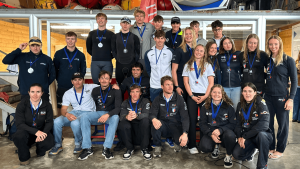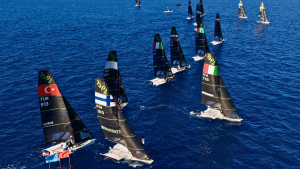New 49er & FX CTS masts:
Below is a list of notes to help you get the best from you new CST mast.
Please read it carefully and continue to give us feedback so we can improve the mast.
Masts concept.
CST supply the mast tubes only. These are sent to the builders with the aluminium castellation rings already glued in place and all holes CNC machined. This ensures all tubes are identical – no matter who assembles them.
Mast fittings, including spreaders, are sourced from various different suppliers around the world and are then assembled by the builders. This concept allows for changes and updates to fittings where it is non-performance affecting. Just like updating the brand or type of fitting on your hulls.
Below is a list of the issues we have identified to date and the solutions.
- Spreader inboard end splitting.
- To date this has only happened on 49er masts.
- This is caused if the gluing of the spreader arm to the aluminium spreader root fails.
- The spreader arms have been strengthened in this area with additional wraps of carbon and a method of repair outlined.
- Spreader breaking in half.
- To date this has only happened on 49er masts.
- Engineering calculations show that the spreader arms are strong enough if the spreader is firmly attached to the wire. This is usual practice in all big boats, but hasn’t been usual in the 49er and FX classes in the past.
- If the spreaders are allowed to move up and down the wire, then they can bend. The spreader strength is greatly reduced once they are able to bend.
- we strongly recommend that the spreader ends are fixed to the wires. This should be done such that the spreaders are straight with full rig tension on.
- Future spreaders will have extra laminate full length to increase the safety factors
- Emergency Rule Changes on Spreaders
- World Sailing are in the process of publishing the following emergency rule changes
- C.9.1(h) The spreaders may be fixed to the shrouds by bonding, fastening or via the use of tape.
- C.9.1 (i) The spreaders may be reinforced with additional composite laminates, and this may include coating, sanding, fairing, and bonding. (See C.9.2(d)) Guidance for a recommended reinforcement is available via the class website.
- Current rules C.9.1 (h) and (i) renumbered at (j) and (k).
- C.9.2 (d) Spreaders modified as permitted by C.9.1(i) shall not be eligible for use at the Olympic Sailing Competition.
- World Sailing are in the process of publishing the following emergency rule changes
- Spreader ends.- wires not fitting
- The first batch of spreader ends was a 2 piece moulding. These were designed to fit 2.5mm wire and some need to be filed lightly to allow the 3mm wire to fit better.
- Later batches are a more robust single-piece moulding and fit the 3mm wire perfectly.
- Masthead- spinnaker halyards wearing
- This is a very complicated machined part and some of the masthead fittings have sharp edges around the bell-shaped exit for the spinnaker halyard.
- We strongly recommend that you file and sand these sharp edges smooth.
- Masthead – spinnaker halyard slipping down the side of the sheave.
- This appears to be only on the 49er masthead. The tolerance will be changed on future batches
- This can be solved by using a bolt and tightening the nut soc the gap is removed. Do not over-tighten. Make sure the sheave is not running on thread. We
- Gooseneck- nut coming loose
- The gooseneck toggle is rotating the gooseneck bolt and the nut is slowly coming loose.
- Check and tighten the nut regularly. Fit the nut with Locktite thread locker.
- An updated design for this part will be coming to solve this.
- Sailtrack- Some tracks have split at the batten pockets like the old tracks did.
- the next batch of track has the internal radius increased to strengthen this area.
- Mastbase- aluminium tenon breaking loose from plastic base.
- We are now using longer fasteners, and gluing the aluminium to the plastic.
- Check inside the spinnaker halyard exit hole. You should be able to see the end of the fastener flush or just entering the hole area. If it looks short, then we recommend fitting longer fasteners.
- Do not remove the aluminium base from the plastic unless you need to replace either part. It is not designed for regular disassembly






